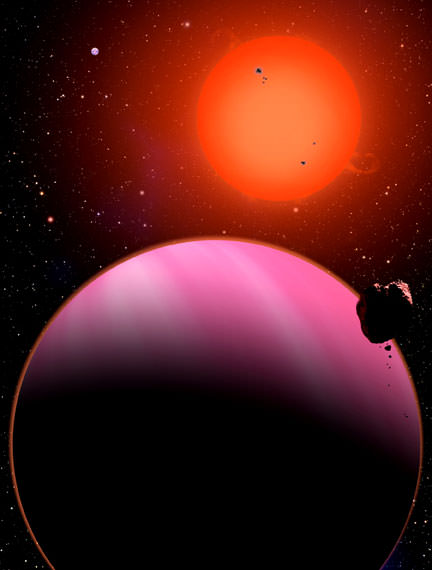[/caption]
Another extrasolar planet has been found, this time a Neptune-sized world orbiting a star 120 light-years from Earth. It was found by a network of automated telescopes set up to search for other worlds, known as “HATNet,” which is operated by the Center in Arizona and Hawaii. This latest extrasolar world, called HAT-P-11b is the 11th planet found by HATNet, and the smallest yet discovered by any projects that are searching using the transit method. As a planet passes directly in front of (transits) its parent star, it blocks a small amount of light coming from the star. In this case, the planet blocked about 0.4 percent of the star’s light. This discovery puts the current extrasolar count at 335.
Transit detections are particularly useful because the amount of dimming tells the astronomers how big the planet must be. By combining transit data with measurements of the star’s “wobble” (radial velocity) made by large telescopes like Keck, astronomers can determine the mass of the planet.
While Neptune has a diameter 3.8 times that of Earth and a mass 17 times Earth’s, HAT-P-11b is 4.7 times the size of Earth and has 25 Earth masses.
A number of Neptune-like planets have been found recently by radial velocity searches, but HAT-P-11b is only the second Neptune-like planet found to transit its star, thus permitting the precise determination of its mass and radius.
The new-found world orbits very close to its star, revolving once every 4.88 days. As a result, it is baked to a temperature of around 1100 degrees F. The star itself is about three-fourths the size of our Sun and somewhat cooler.
There are signs of a second planet in the HAT-P-11 system, but more radial velocity data are needed to confirm that and determine its properties.
Another team has located one other transiting super-Neptune, known as GJ436b, around a different star. It was discovered by a radial velocity search and later found to have transits.
“Having two such objects to compare helps astronomers to test theories of planetary structure and formation,” said Harvard astronomer Gaspar Bakos, who led the discovery team.
HAT-P-11 is in the constellation Cygnus, which puts in it the field of view of NASA’s upcoming Kepler spacecraft. Kepler will search for extrasolar planets using the same transit technique pioneered by ground-based telescopes. This mission potentially could detect the first Earth-like world orbiting a distant star. “In addition, however, we expect Kepler to measure the detailed properties of HAT-P-11 with the extraordinary precision possible only from space,” said Robert Noyes, another member of the discovery team.


I think calling it a Neptune sized planet would be more accurate. I strongly doubt this world is anything like Neptune.
@ Phil
Uranus and Neptune are about the same size and mass.
Citation: “This mission potentially could detect the first Earth-like world orbiting a distant star”
Didn’t we discover that some articles ago?
Whens Kepler going up?
When are they going to find a planet the size of Uranus??
I’d like to here about a super-Uranus too…
Joking!
In all seriousness, couldn’t you have also picked Uranus as an analogy since this body is substantially bigger/heavier than both Neptune and Uranus (and they are in comparison nearly the same size)?
Kepler goes up in 44 days. Cant wait!
Oh my God – that planet just looks FABULOUS!
Oooh, I love these ones with artist renderings in them. Such science!!!
Well we can’t take pictures of exoplanets 120 light years away yet! I can’t wait for the JWST in 2013 and roll on 2015, the truth about Pluto will finally be revealed. I’ll laugh if they find an alien civilisation!